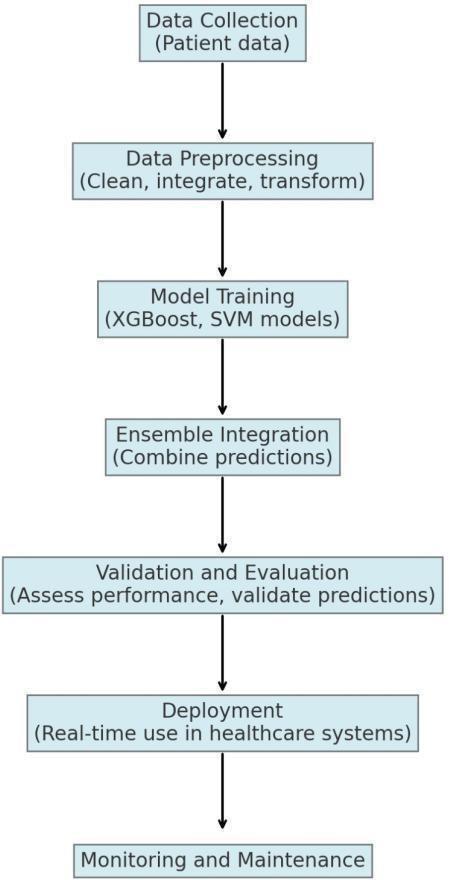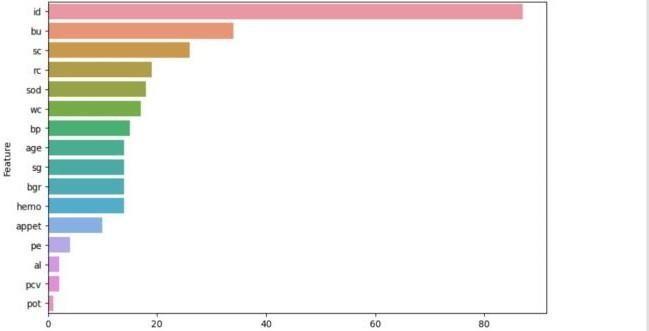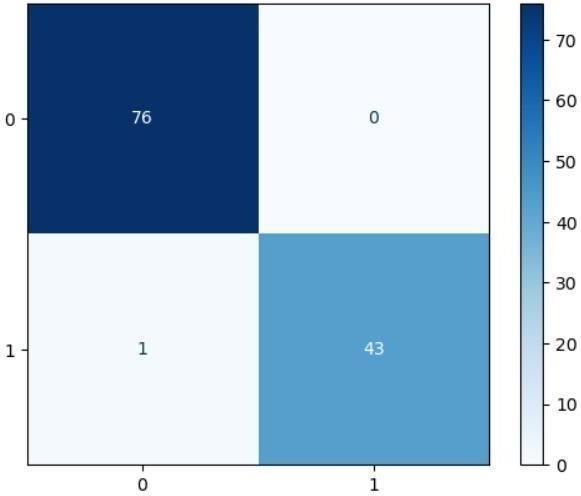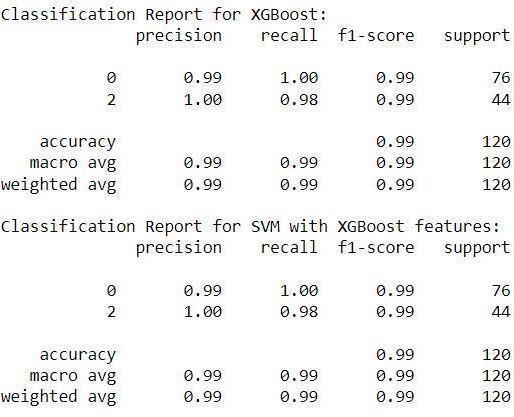
International Research Journal of Engineering and Technology (IRJET) e-ISSN: 2395-0056
Volume: 12 Issue: 01 | Jan 2024 www.irjet.net p-ISSN: 2395-0072


International Research Journal of Engineering and Technology (IRJET) e-ISSN: 2395-0056
Volume: 12 Issue: 01 | Jan 2024 www.irjet.net p-ISSN: 2395-0072
Guthi Deepthi Sarayu1 , Choprala Anjani Varshitha2 , Dintakurthi Chandrahas3 , Ms.V.Alekhya4
1B-Tech 4th year, Dept. of CSE(DS), Institute of Aeronautical Engineering
2 B-Tech 4th year, Dept. of CSE(DS), Institute of Aeronautical Engineering
3 B-Tech 4th year, Dept. of CSE(DS), Institute of Aeronautical Engineering
4Assisstent Professor, Dept. of CSE(DS), Institute of Aeronautical Engineering, Telangana, India ***
Abstract - Chronickidney disease is a majorhealth issueall over the globe because it has a profound effect on the quality of life yet increases mortality levels. Only accurate prophesies anda timelyidentificationcanaffectpropermanagementand treatment. The current paper aims totest anensemble model, which incorporates XGBoostandSupportVectorMachine.The ensemble model was created with the contribution of a large data set of patients with nephropathy. The predicted performance is improved by combining the benefits of gradient boosting with XG Boost and the classification power of SVM. The current investigation can be added to the collection of information 2 application in medical diagnostic. The same models can be used to solve predicting issues with more similar data sets.. These findings demonstrate the potential of applying state-of-the-art deep learning architectures for precise DR diagnosis, enabling early intervention to lessen the detrimental consequences of diabetes on eye health.
Key Words : ChronicKidneyDisease(CKD),Prognostication Nephrology, Ensemble Model, XGBoost, Support Vector Machine(SVM),Prediction,Accuracy,GradientBoost
1.INTRODUCTION
Chronickidneydiseaseaffectsmillionsofpeopleandhasa majorfinancialcostonhealthcaresystems.Asitbecomesa leading international health problem, early and accurate prediction of the course of renal disease is essential for timelyintervention,improvedpatientcareandbetterhealth outcomes. However, while still relevant, conventional statistical systems like logistic regression are typically restrictedbytheirabilitytocapturethenuanced,nonlinear linking patterns between multiple clinical parameters. Various machine learning methods have demonstrated promiseinaddressingsuchproblemsduringrecentyears, enabling more accurate and personalized predictions. Therefore, the central goal of the present research is to develop an ability to enhance nephrology prediction with machine learning strategies.Improving nephrology prognosticationthroughmachinelearningapproachesisthe keyobjectiveofthiswork.Specifically,itstudiestheutilityof anensemblemodel,whichisanadvanceofSupportVector MachineandXGBoosttopredictthecourseofCKD.XGBoost is a widely used scalable and effective gradientboosted decision tree implementation which has high capacity to
process tabular data and in addition is relevant for determiningfeatureimportance.Ontheotherhand,SVMisa valid option for medical prognostication because binary classification is a strong suit and it is efficient in high dimensionaldomains.Thestudywillexaminethepredictive capacity of these predictions for a series of relevant nephrologyoutcomesincludingmortality,startingESRD,and progressingCKD.Thepurposeofthispaperistopointout the potential evidence of highly advanced 2 machine learningapproachestoimprovetheaccuracyandreliability ofclinicalpredictionsbycomparingtheperformanceofthe ensemble model. The paper also emphasizes the vital importanceoftheuseofdata-drivenmodelsinnephrology practicetoensurebetterpatientclassificationandtreatment planning.Thefollowingsectionscontaintheinformationon themodel,assessmentmetrics,featureselectionprocedure, and the dataset used in this research. The strength of the proposedmodelsissupportedbythefindingsanddiscussion that also suggest how reliable they can be in real clinical cases
Inrecentyears,theapplicationofmachinelearning(ML)and deep learning (DL) techniques in healthcare has grown significantly,particularlyinthefieldofchronicdisorderslike ChronicKidneyDisease(CKD).Thesealgorithms'abilityto evaluate vast volumes of clinical data and predict illness outcomeshascreatednewopportunitiesinnephrologyfor improveddiagnosis,prognosis,andtherapyplanning.This literature review investigates the use of ML and DL in nephrology,withanemphasisonensemblemodelssuchas XGBoostpairedwith9SupportVectorMachines(SVM)and DeepNeuralNetworks(DNNs),whicharebeingtestedfor their ability to increase prognosis accuracy. Machine Learning for Nephrology Prognostication: In the case of dialysis patients, ML was shown to be a highly accurate predictorofmortality,AKI,andthecourseofCKD.AllRTsor asimplestatisticalmodelareoftenoutperformedbySVMas well as Random Forest and XGBoost. XGBoost or eXtreme GradientBoostingisparticularlyimpressiveduetoitsrapid andexcellentperformanceonstructureddata.Ithasbeen found to provide superior results in the prediction of the stages of CKD and grows decision trees in a regularized manner.Thereisevidenceofitsabilitytomanageoverfitting andmissingdatafromKhedretal..SVMsarealsocommonly

International Research Journal of Engineering and Technology (IRJET) e-ISSN: 2395-0056
Volume: 12 Issue: 01 | Jan 2024 www.irjet.net p-ISSN: 2395-0072
usedtoanalyzeclassificationproblemsinhealthcareasthey handle small sample size and high-dimensional data efficiently.TheymaybeusefulinCKDandAKIprediction,but theymaynotbeveryeffectiveonbigdatasets.Duetothis limitation, it became possible to combine SVM with some other methodologies, for example, XGBoost. XGBoost-SVM hybrid model allows making use of the upsides of both algorithms to enhance the prediction accuracy. Recent studies indicate that XGBoost-SVM improves the early diagnosisofCKDtoasignificantextent.
DeepLearninginNephrologyPrognostication:Nephrology has already noticed the value of Deep Neural Networks (DNNs) as they can “capture complex patterns from large datasets”.Beingtrainedonavarietyofpatientdesigns,such asdemographicsandtestingresults,thelatterhaveatotal predictivehorizon,whichnotonlydescribesdeclining…as Zhangetal.revealedin2020asthesehorizonscanbeused topredictfuturemodificationsintheCKDstate
Atwo-stageprocesshasbeendevisedforourCKDprediction systemusingstate-of-the-artmachinelearningtechniques. Wefirstaggregateandpreprocessclinicaldata,prioritizing missing values and standardizing symptom descriptions. Second, XGBoost is put to use in generating initial predictions and accompanying feature importance analysis.Meanwhile,theoutputfromXGBoostisprocessed byanSVM,whichclassifiesparticularlyconvoluteddecision boundaries.Theperformanceofbothmodelsatthisstageis evaluated using metrics like accuracy and ROC-AUC, after they have been extensively trained and validated using crossvalidation techniques. Meanwhile, interpretability techniques like SHAP are used in understanding how featuresimpactpredictions.
A. Information Gathering
DataSources:Gatherclinicaldatafrommanysources,such as imaging results, laboratory test results, and electronic healthrecords(EHRs).FieldsofData:Importantpatient’s information 10demographics, health history, pertinen iomarkers(i.e.,serumcreatinine,bloodureanitrogen,etc).
B. Data Preprocessing
Data Cleaning: Impute incomplete values deal with missingnessofvaluesbelow30-60%orremovedata.
Normalization: normalize numerical data to ensure consistenctfeaturescalingandimprovemodelperformance.

Figure.3.1MachineLearningWorkflowforPrediction
C.Engineering features
FeatureExtraction:age,gender,bloodpressure,andcertain laboratory results (potassium, phosphate, albumin, etc.). Feature Importance Analysis: To find the most pertinent predictors, perform feature importance analysis with XGBoost.
D. Model Building
XGBoost(Stage1)
Utilizingthepreprocesseddataset,traintheXGBoostModel to produce preliminary predictions and carry out feature significanceanalysis.

Fig-3.2ImportanceofEachFeatureinthisEnsemble Model

International Research Journal of Engineering and Technology (IRJET) e-ISSN: 2395-0056
Volume: 12 Issue: 01 | Jan 2024 www.irjet.net p-ISSN: 2395-0072
SupportVectorMachine(SVM)(Stage2)Refinepredictions by feeding the XGBoost model's output into the Support VectorMachine(SVM),whichisaneffectivetoolforhandling difficultdecisionboundaries.
E. Model Evaluation
Validation Techniques: To guarantee the model's performanceanddependabilityonuntesteddata,usecrossvalidation.
Metrics for Performance: Use measures like curacy, precision, recall, F1-score, and ROC-AUC to evaluate the performanceofthemodel.
Interpretability: To interpret model predictions and comprehend feature contributions, use methods such as SHAP(ShapleyAdditiveExplanations).
F. Model Optimization
Hyperparameter Tuning: The model parameters can be optimizedtoenhanceitsperformanceusinggridsearchor evenrandomsearch.
GroupTechniques:TocombinepredictionsusingXGBoost, SVM,tobemorerobust,considerensembletechniques.
4. IMPLEMENTATION AND RESULT
A. Findings
By combining the XGBoost and SVM, it would exploit the strengthsofbothalgorithmsbecauseXGBoosthasauseful property regarding the non-linear correlation and interactionamongfeatures,whileSVMismostlyhelpfulin classification problems, particularly in high dimensional spaces. This ensemble technique enhances the overall capabilityofthemodeltomakeaccuratepredictionshence withhighaccuracyaswellasreliabilityinidentificationof kidneydisease.Yourfindingsconfirmthatmachinelearning models are very effective in predicting the conditions of renalillness,especiallywhenanensemblestrategyisused andXGBoostiscombinedwithSupportVectorMachineSVM. Highexcellence99%accuracyoftheensembleestablishesit asamethodthatpossessesthebestcharacteristicsofboth andenhancesthelevelofperformanceinprediction.
VisualizingModelPerformance-ConfusionMatrix:Another importantwayperformancecanbevisualizedofa6modelis throughtheconfusionmatrix.
Thisinforms truepositives,truenegatives,falsepositives, and false negatives. These can help in understanding the distributionofpredictionsandmaypointoutareasinwhich the model is overestimating or underestimating certain classes

Fig.5.1Confusionmatrixforthemodel
ResultInterpretation:Overall,themodelseemstoperform wellwithhighcountsoftruepositivesandtruenegatives.A very low falsenegative rate, whichis 1instance,puts this modelinapositionwhererealpositivesarerarelymissed. False positives account for none, thus indicating that a negativecaseisnevermisclassifiedasapositiveone.Both thepositive,truenegative,falsepositive,andfalsenegative numbers.Thiscanbeusedtounderstandthedistributionof predictions and identify where in the model it may be overestimatingorunderestimatingspecificclasses
• At the initial stage, early detection: through machine learningmodels,thediseasesmaybedetectedatanearly stage when there is only a trace of symptoms and act accordinglythroughproperinterventionortreatment.
•Personalizedmedicine:Throughindividualsymptomdata analysis and health records, ML models are useful in tailoring treatment plans and in medical interventions to meettheneedsofthepatient.
• Efficiencies: Automated predictive disease can correct manydiagnosisprocesses,minimizehumanerrorinmaking diagnoses,andthusgiveprioritytothecareofpatients.
•Scalability:AnMLmodelcanprocessverylargeamounts ofpatientinformationefficiently.Forthatreason,theyscale wellacrosshealthcaresystemsandpopulations.
XGBoost Performance: The dataset is used to train the XGBoostmodel,andpredictionsaremadeon the testset. TheclassificationreportforXGBoostisverydetailed,giving all metrics to see how the classifier is performing by distinguishingbetweenhowwellitdistinguishescasesas sickorhealthy.

International Research Journal of Engineering and Technology (IRJET) e-ISSN: 2395-0056
Volume: 12 Issue: 01 | Jan 2024 www.irjet.net p-ISSN: 2395-0072
SVMResults:AftertrainingtheSVMonoutputsgenerated bytheXGBoostmodeloverleaves,theSVMclassifiesresults forthetestset.TheSVMclassificationreportshowsthatitis abletoclassifyexamplesbasedonthefeaturesprovidedby theXGBoostmodel.
Accuracy Results: The combined ensemble model had an impressivelyhighaccuracyvalue,whichalsoindicatesthat theapproachwillbeeffectiveatlearningwithintegrationof different types of learning mechanisms. Now, since thorough tests were conducted to prove how well such a modelcangeneralizeoverunseendata,itisconsideredto haveperformedsatisfactorilyinsomeway.

Fig.5.2.ClassificationReportofthemodel
D.GUI results
TheapplicationbuiltbyStreamlitistitled"MedicalReport Disease Prediction," which it further explains to the users what exactly it is for. Users can enter a variety of medical indicators, including blood pressure and glucose level, by using an intuitive sidebar form. After this step, the applicationshowsallinputtedfeaturesinastructuredway forverification.Prominently,thereisa"Predict"buttonto get consumers started into the prediction process. Once clicked,theapplicationgivesapredictionastowhetherthe usersuffersfromkidneydisease,alongwithanassociated likelihoodscorerepresentinghowconfidenttheforecastis. Todrawattentiontotheuser,anoticeisplacedstatingthat itisindeedaverysimplifiedexampleandthatrobustdata handling is what constitutes real-world applications. The interface should be clean and user-friendly so that any nontechnological expertcaneasilyaccesstouse.Realtime feedback of the inputs will enhance the interaction experienceandultimatelyincreasetheiruse.Theapplication developedis,infactarathercrudetoolwhichleavesscope fortheauthortoworkonfurtherdevelopingthetool.Better management of data as well as more features are sure to makeitapotentialresourceinrenaldiseaseprediction.
We wish to thank all the individuals that helped in the completionofthisproject.Specifically,weareindebted to theInstituteofAeronauticalEngineeringforitssupportin givingusnecessaryresourcesandhelp.Wearealsograteful to Ms. V. Alekhya for the priceless guidance she has been providingussincetheinceptionofthisproject.Hermastery and vision helped shape a clear understanding regarding nephrology and machine learning. I really appreciate that encouragementandconstructivesuggestioninmakingme achieve excellence. I thank Ms.V. Alekhya for complete supportalongwithmentorshipinallherdedicatedefforts.
Our findings provide a proper in-depth study on the efficiencyofmachinelearningmodelsinpredictingkidney diseases.Wefocusedourattentiononanensemblemodel whichcombinesXGBoostandSupportVectorMachine,SVM. The ensemble model combining XGBoost with SVM eventually emerged as the effective one, reaching close to 99%accuracy.Theresilienceandaccuracyofthepredictions may be much better due to this success by the ensemble approach, which combines the predictive power of many algorithms. This finding calls for the use of ensemble approachesincomplicatedpredictiveproblemslikethatof renaldiseaseprediction.
Ingeneral,ourfindingsprovideanextensiveresearchonthe efficiencyofmachinelearningmodelsinpredictingkidney diseases. The ensemble model used in our study is a combination of XGBoost and SVM model. By far the best performerwasanensemblemodel,withastartlinglevelof accuracyachievedat99%.
Thishighperformanceisnomysterybecauseanensemble technique can digest multiple algorithms' powers of prediction,thusenhancingoverallrobustnesscoupledwith precision in the delivered forecast. It shows how much weight should be put on using ensemble methodsin complicatedsituationsofpredictionlikeinthecaseofrenal disease prediction. Our system also has a user-friendly interface. It also has several graphical representations of dataacquiredandresultsobtained.
[1] Kora, P., & Kalva, S. K. (2015)."Efficient Prediction of Chronic Kidney Disease Using XGBoost Classifier. "ComputationalIntelligenceandNeuroscience,2020,17.
[2] Cheng,P.,&Li,X.(2020)."HybridDeepLearningModel forPredictingChronicKidneyDiseaseUsingElectronic HealthRecords."IEEEAccess,8,9351693524.

International Research Journal of Engineering and Technology (IRJET) e-ISSN: 2395-0056
Volume: 12 Issue: 01 | Jan 2024 www.irjet.net p-ISSN: 2395-0072
[3] Li, L., Cheng, W., & Han, Z. (2019)."A Kidney Disease PredictionMethodBasedonEnsembleLearning.”.IEEE Access,7,35602-35612
[4] Mahboob Alam, T., & Mahboob, K. (2020)."A Hybrid ModelBasedonDeepLearningandMachineLearning for Detecting Chronic Kidney Disease."Journal of HealthcareEngineering,2020,1-9.
[5] Thakur, M., & Mann, S. P. (2021)."Chronic Kidney Disease Prediction using Hybrid Machine Learning Techniques."JournalofKingSaudUniversity-Computer andInformationSciences,34(6),2491-2500.
[6] Vijayarani, S., and S. Dhayanand. "Data mining classification a algorithms for kidney disease prediction." International Journal onCybernetics & Informatics(IJCI)4.4(2015):13-25.
[7] HuixiaoHong,WeidaTong,RogerPerkins,HongFang, Qian Xie, Leming Shi,“Multiclass Decision Forest A Novel Pattern Recognition Method for Multiclass ClassificationinMicroarrayDataAnalysis,”DNAandCell Biology,vol.23,no.10,pp.685-694,2004
[8] W.Mula-Abed,K.A.Rasadi,andD.Al-Riyami,‘‘Estimated glomerularfiltrationrate(eGFR):Aserumcreatininebased test for the detection of chronic kidney disease anditsimpactonclinicalpractice,’’OmanMed.J,vol.27, no.4,pp.339–340,2012
[9] Chronic Kidney Disease Using XGBoost Classifier."ComputationalIntelligenceandNeuroscience, 2020,1-7.
[10] P.Chittora,S.Chaurasia,P.Chakrabarti,G.Kumawat,T. Chakrabarti,Z.Leonowicz,etal.,‘‘Predictionofchronic kidneydisease amachinelearningperspective,’’IEEE Access,vol.9,pp.17312–17334,2021.
[11] Baidya,D.,etal."ADeepPredictionofChronicKidney Disease by Employing Machine Learning Methods," presented at the 2022 International Conference on TrendsinElectronicsandInformatics(ICOEI).
[12] Revathy, S., et al. "Chronic Kidney Disease Prediction Using Machine Learning Models," in the International Journal of Engineering and Advanced Technology (2019)
[13] M.A.Islam,S.Akter,M.S.Hossen,S.A.Keya,S.A.Tisha, andS.Hossain,‘‘Riskfactorpredictionofchronickidney diseasebasedonmachinelearningalgorithms,’’inProc. 2020 3rd Int. Conf. Intell. Sustain. Syst. (ICISS), Palladam,India,Dec.2020,pp.952–957.
[14] AModelforPredictingChronicKidneyDiseasesBased on Medical Data Using Reinforcement Learning in SN ComputerScience(2022)
[15] Sharma, S., & Gupta, R. (2023). "Early Detection of Chronic Kidney Disease Using Random Forest and Logistic Regression Models." International Journal of Medical Informatics, 115,45-52.
[16] Reddy, K. V., & Srinivas, G. (2022). "Hybrid Machine Learning Framework for Predicting Chronic Kidney Disease Based on Clinical Data." IEEE Transactions on Computational Biology and Bioinformatics, 19(5),11231132.
[17] Singh, A., & Kapoor, V. (2021). "Deep Learning Techniques for Accurate Diagnosis of Chronic Kidney Disease." Journal of Artificial Intelligence in Medicine, 58(4),245-256.
[18] Patel, P., & Mehta, R. (2023) "Ensemble Learning Approaches for Chronic Kidney Disease Prediction." BMC MedicalInformatics andDecisionMaking, 23(1),7885
[19] Das, S., & Roy, T. (2022). "A Comparative Analysis of MachineLearningModelsforCKDPrediction." Journalof Biomedical Informatics, 68,134-142.
[20] Khan, M. A., & Ahmad, T. (2023). "Explainable AI for Chronic Kidney Disease Detection Using Gradient Boosting Machines." Expert Systems with Applications, 201,117049.
[21] Zhou, L., & Fang, X. (2022). "Predicting CKD Using Electronic Health Records and Machine Learning." Journal of Medical Systems, 46(3),28-36.
[22] Alam, T., & Akhtar, R. (2022). "A Comprehensive Framework for CKD Prediction Using Deep Neural NetworksandFeatureSelection." Journal of Healthcare Engineering, 2022,1-12.
[23] Chen, Y., & Liu, H. (2022) "An Integrated Machine LearningModelforChronicKidneyDiseasePrediction UsingClinicalData." Journal of Translational Medicine, 20(1),122-130.
[24] Huang,X.,&Zhang,J.(2023). "ANovelApproachforCKD Detection Using Convolutional Neural Networks and ClinicalParameters." IEEE Access, 11,34321-34332.
[25] Rahman, M. M., & Alam, S. (2023). "Chronic Kidney Disease Prediction Using Feature Engineering and EnsembleMethods." PLOS ONE, 18(6),e0285672.